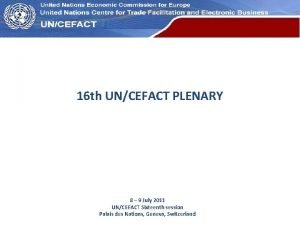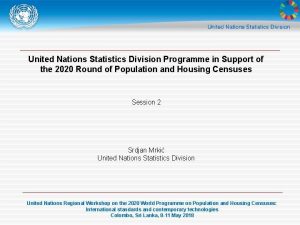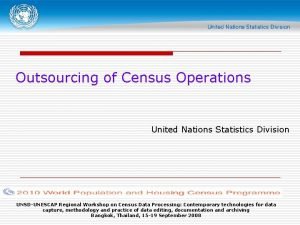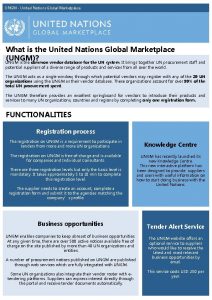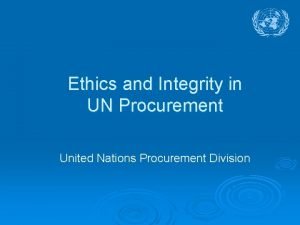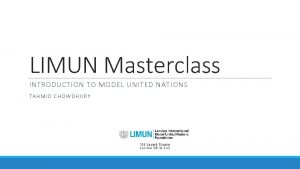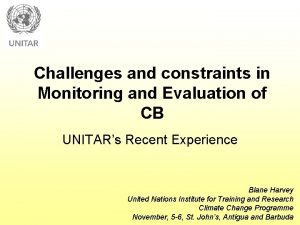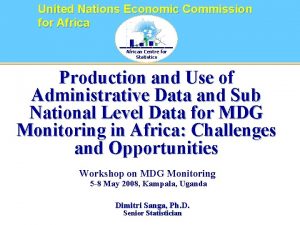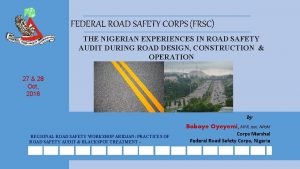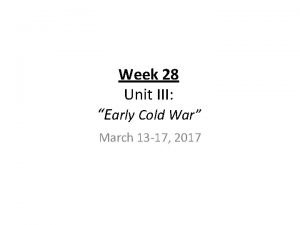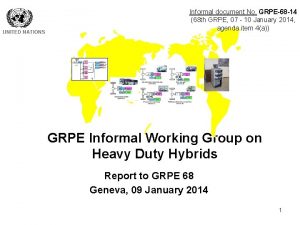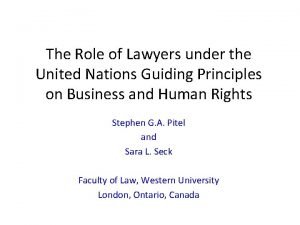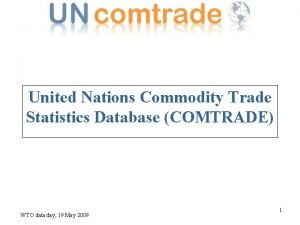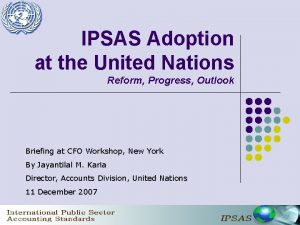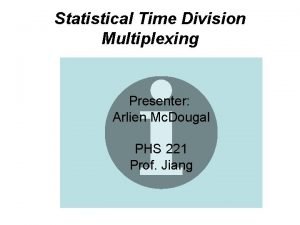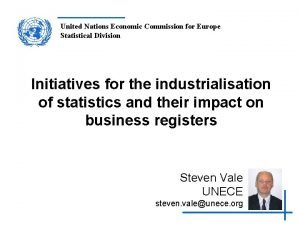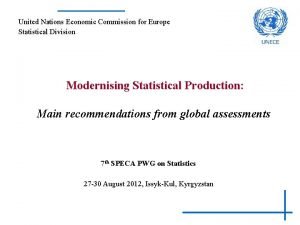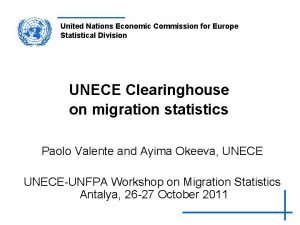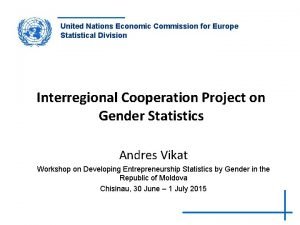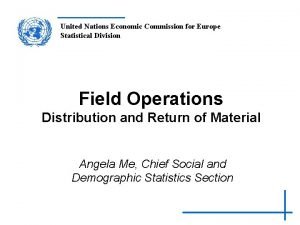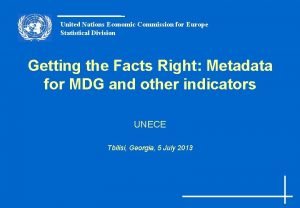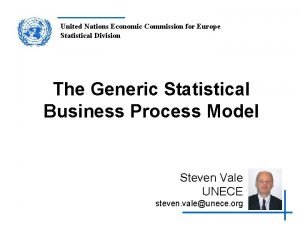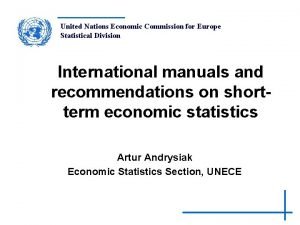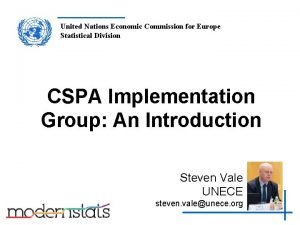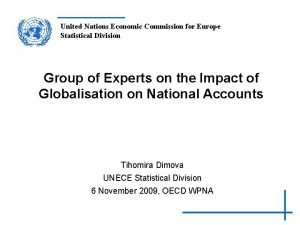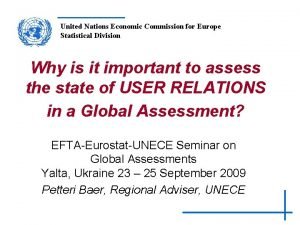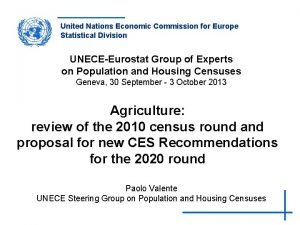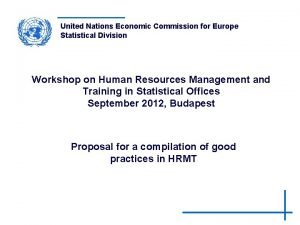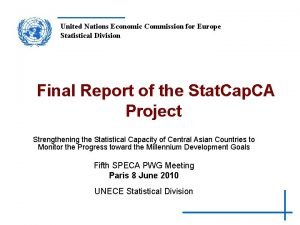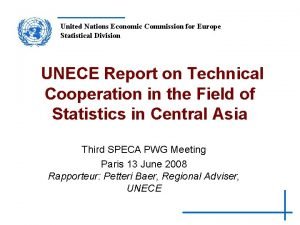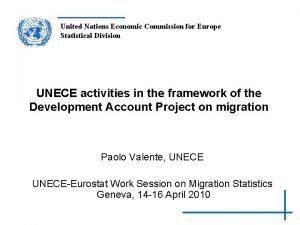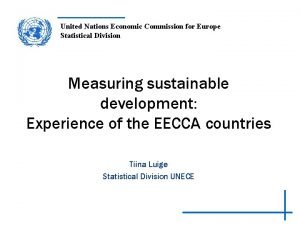United Nations Economic Commission for Europe Statistical Division

































- Slides: 33

United Nations Economic Commission for Europe Statistical Division Economic Characteristics in the Census Questionnaire Angela Me, Chief Social and Demographic Statistics Section

Economic Characteristics What is the objective of collecting economic characteristics in the census? - UNECE Statistical Division Dushanbe, 12 -16 March 2007 Slide 2

To classify the population according to Activity Status - UNECE Statistical Division Dushanbe, 12 -16 March 2007 Slide 3

Activity Status Economically active population Not economically active population Persons who provide the supply of labour, as employed or as unemployed, for the production of goods and services Persons who are not economically active - UNECE Statistical Division Dushanbe, 12 -16 March 2007 Slide 4

Activity Status Economically active population I. II. Not economically active population Persons who produce goods and services supplied to units other than themselves or their household Persons who produce goods for own consumption I. II. Persons who produce services for own consumption Persons who do not produce any good or service (if the amount produced is quantitatively important in relation to the total supply of that good in the country) III. Persons who provide paid domestic services - UNECE Statistical Division Dushanbe, 12 -16 March 2007 Slide 5

Activity Status What is the time-span to consider if the person is engaged in the “production”? - UNECE Statistical Division Dushanbe, 12 -16 March 2007 Slide 6

Activity Status Short reference period: one week or one day Current activity status (core) Usual activity Status Long reference period: one year Age limit: 15 -75(? ) - UNECE Statistical Division Dushanbe, 12 -16 March 2007 Slide 7

Currently Economically Active Population Employed I. II. Unemployed Persons who performed work for pay or profit, in cash or in kind Persons who were temporarily absent from a job in which they had already worked and to which they maintain a formal attachment, or from a self-employed activity such as a farm, a business enterprise or a service undertaking (paras 241244) Persons who are: v v v Without work (not in wage employment or selfemployed) Currently available for work Seeking work - UNECE Statistical Division Dushanbe, 12 -16 March 2007 Slide 8

Economic Characteristics - UNECE Statistical Division Dushanbe, 12 -16 March 2007 Slide 9

Current Activity Status How to assess the current activity status with a census questionnaire? There are different practices It is not sufficient to include the right definitions in interviewer's manual to measure the right concepts. How questions are asked matters! - UNECE Statistical Division Dushanbe, 12 -16 March 2007 Slide 10

Measurement of Current Activity Status: standard approach Have you worked? Yes No Temporary absent? Yes No Looking for work? Employed Information on job: occupation, status, …. Ready to take up work? Yes Unemployed - UNECE Statistical Division Dushanbe, 12 -16 March 2007 No Non active Slide 11

Measurement of Current Activity Status: standard approach Example: UK Last week, were you doing any work as employee, self employed or in your own/family business? - UNECE Statistical Division Dushanbe, 12 -16 March 2007 Slide 12

Measurement of Current Activity Status: standard approach Example: Canada Last week, how many hours did you/this person spend working for pay or in self employment? Include: Working for wages, salary, tips or commission; Working in your/his/her own business, farm or professional practice, alone or in partnership Working directly towards the operation of a family farm or business without formal pay arrangements (e. g. assisting in seeding, doing accounts) Number of hours None - UNECE Statistical Division Dushanbe, 12 -16 March 2007 Slide 13

Measurement of Current Activity Status: standard approach Example: UN Technical Report Did you/this persons work at any time LAST WEEK, either full time or part time? Work includes part-time work such as delivering papers, or helping without pay in a family business or farm. It also includes active duty in the Armed Forces. Work does NOT include own housework, school work or volunteer work. Subsistence activity includes fishing, growing crops, etc. NOT primarily for commercial purposes. Read each category and mark (X) the ONE box that applies q Yes, worked full time or part time at a job or business AND did NO subsistence activity q Yes, worked full time or part time at a job or business AND did subsistence activity q Yes, did subsistence activity only q No (did not work OR did only own housework, school work, or volunteer work) - UNECE Statistical Division Dushanbe, 12 -16 March 2007 Slide 14

Measurement of Current Activity Status: standard approach Shortcoming: When asked about work, people tend to exclude non-formal work Some prompts can be added: § Did you sell food or snacks at the market/bus-stop/school? § Did you sell food from home? § Did you sew for pay? - UNECE Statistical Division Dushanbe, 12 -16 March 2007 Slide 15

Measurement of Current Activity Status: another approach - UNECE Statistical Division Dushanbe, 12 -16 March 2007 Slide 16

Measurement of Current Activity Status: another approach Example: Ireland How would you describe your present principal status? • • Working for payment and profit Looking for first regular job Unemployed Student or pupil Looking after home Retired from payment Unable to work Other - UNECE Statistical Division Dushanbe, 12 -16 March 2007 Employed Unemployed Not active Slide 17

Measurement of Current Activity Status: DISCOURAGED approach - UNECE Statistical Division Dushanbe, 12 -16 March 2007 Slide 18

CES Recommendations The “main source of livelihood” is a useful concept to complement the measurement of the economically active population and of status in employment. However, it is NOT suitable for the measurement of economic activity status and should not be used to classify the population according to activity status. - UNECE Statistical Division Dushanbe, 12 -16 March 2007 Slide 19

Beyond the Activity Status Classification Once the persons have been identified as Employed Unemployed Not Economically Active Different characteristics can be collected for each of the three population groups - UNECE Statistical Division Dushanbe, 12 -16 March 2007 Slide 20

Employed Persons Core Topics Non Core Topics Occupation • Industry • Status in employment • Type of sector • • Informal employment • Type of place of work • Time usually worked • Number of persons working in the local unit of establishment With reference to the “main” job - UNECE Statistical Division Dushanbe, 12 -16 March 2007 Slide 21

Occupation Definition: Type of work, main tasks and duties Open question Useful to ask for both the occupational title and a brief description of tasks and duties performed on the job Responses to be coded according to ISCO-88. New revision expected to be finalized in 2008 - UNECE Statistical Division Dushanbe, 12 -16 March 2007 Slide 22

Industry Definition: kind of production or activity of the establishment Open question Useful to collect name and address of enterprise for those who have fixed place of work Responses to be coded according to the latest revision of ISIC. - UNECE Statistical Division Dushanbe, 12 -16 March 2007 Slide 23

Status in Employment Definition: Type of contract, economic risk Structured question. Recommended classification: • • • Employees Employers Own-account workers Contributing family workers Members of producers’ co-operatives Persons not classifiable by status - UNECE Statistical Division Dushanbe, 12 -16 March 2007 Slide 24

Non-Core topics on the characteristics of main job Out of 38 analyzed countries the following number of countries included the following topics: Number of persons working in the local 8 unit 21% Institutional unit 29% 21% 84% 2% Type of contract within employees Place of work Time usually worked - UNECE Statistical Division Dushanbe, 12 -16 March 2007 11 8 32 1 Slide 25

Unemployed Persons Non Core Topics • Time related unemployment • Duration of unemployment Occupation, industry, status in employment should be collected for unemployed persons as well - UNECE Statistical Division Dushanbe, 12 -16 March 2007 Slide 26

Characteristics of unemployed persons Out of 38 analyzed countries the following number of countries included the following topics: Characteristics of previous job Duration of unemployment 14 13 37% 34% Two countries put a limit to consider previous employment - UNECE Statistical Division Dushanbe, 12 -16 March 2007 Slide 27

Characteristics of unemployed persons Additional information on the nature of unemployment was collected in some countries: • • • Are you looking for the first job? How long have you been looking for a job? When did you last take any steps to seek a work? Have you ever worked? Did you stop looking for a job and what are the reasons? (Armenia) - UNECE Statistical Division Dushanbe, 12 -16 March 2007 Slide 28

Non active persons Core Classification • Students • Pension or capital income recipients • Homemakers • Others - UNECE Statistical Division Dushanbe, 12 -16 March 2007 Slide 29

All persons Non Core Topics • Source of livelihood (last 12 months) • Income • Providers of unpaid services, volunteers - UNECE Statistical Division Dushanbe, 12 -16 March 2007 Slide 30

Characteristics of unemployed persons Out of 38 analyzed countries the following number of countries included the following topics: Source of livelihood 15 4 Income - UNECE Statistical Division Dushanbe, 12 -16 March 2007 39% 11% Slide 31

Source of livelihood Principal source of income from which the consumption of each person was financed during a reference period 12 months? - UNECE Statistical Division Dushanbe, 12 -16 March 2007 Slide 32

Source of livelihood CES Recommendations Kyrgyzstan last census (1. 0) Employment: (1. 0) Salaried employment (1. 1) Wage employment (1. 2) Self-employment (1. 1) at enterprise, organization, institution (1. 2) in a farm (1. 3) for individuals (including serving households) (2. 0) Property and other investments (3. 0) Pensions of all types (2. 0) Non-salaried employment (3. 1) Paid by the State and other public bodies (3. 2) Paid by enterprises, institutions, co-operative organizations and others (4. 0) Other transfers: (4. 1) Sickness and maternity allowances (4. 2) Unemployment benefits and relief (4. 3) Scholarship (4. 4) Benefits and assistance other than pensions, (5. 0) Loans or reduction of savings, realisation of capital (6. 0) Dependent (mainly supported by another person or persons) (7. 0) Other sources (2. 1) owners of enterprises, farms (employer) (1. 2) on individual basis (1. 3) unpaid at farms (3. 0) Scholarship (4. 0) Pension (5. 0) Benefits and allowances (excluding unemployment) (6. 0) Unemployment benefits (7. 0) Other type of state maintenance (8. 0) Income from property (9. 0) On dependence (10. 0) Other sources - UNECE Statistical Division Dushanbe, 12 -16 March 2007 Slide 33
 United nations economic commission for europe
United nations economic commission for europe United nations statistics division
United nations statistics division United nations statistics division
United nations statistics division United nations
United nations Undss
Undss What is ungm
What is ungm Six main organs of the united nations
Six main organs of the united nations Role of united nations
Role of united nations Ethics and integrity at the united nations
Ethics and integrity at the united nations Introduction to model united nations
Introduction to model united nations Challenges in monitoring and evaluation
Challenges in monitoring and evaluation United nations zambia
United nations zambia United nations
United nations United nations
United nations What is mun
What is mun The agency sponsored by the united nations that compiles
The agency sponsored by the united nations that compiles Frsc vision and mission statement
Frsc vision and mission statement Christian saunders united nations
Christian saunders united nations Cold war
Cold war Patricia nemeth united nations
Patricia nemeth united nations United nations
United nations Un introduction
Un introduction United nations
United nations Uno flag
Uno flag United nations basic principles on the role of lawyers
United nations basic principles on the role of lawyers Anatolia college mun
Anatolia college mun Un commodity trade statistics database
Un commodity trade statistics database Unicef
Unicef United nations convention on the carriage of goods by sea
United nations convention on the carriage of goods by sea Ipsas united nations
Ipsas united nations Opsp united nations
Opsp united nations Statistical time-division multiplexing
Statistical time-division multiplexing Education commission 1952-53
Education commission 1952-53 Sections 1-6 1-7 commission and graduated commission
Sections 1-6 1-7 commission and graduated commission
